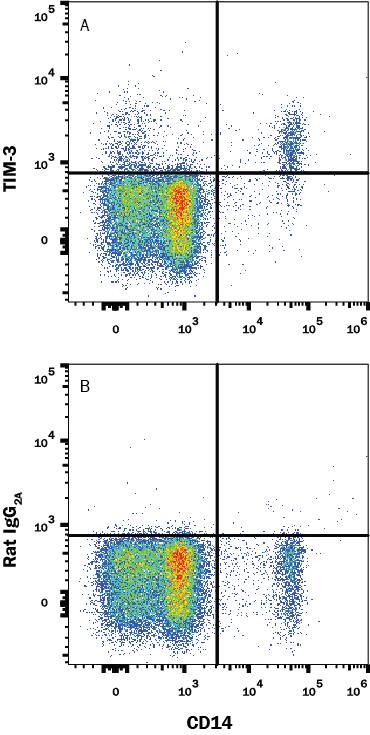Human TIM-3 Antibody
R&D Systems, part of Bio-Techne | Catalog # MAB2365R


Key Product Details
Species Reactivity
Applications
Label
Antibody Source
Product Specifications
Immunogen
Ser22-Arg200
Accession # Q8TDQ0.2
Specificity
Clonality
Host
Isotype
Scientific Data Images for Human TIM-3 Antibody
Detection of TIM‑3 in Human PBMCs by Flow Cytometry.
Human peripheral blood mononuclear cells (PBMCs) were stained with (A) Rat Anti-Human TIM-3 Monoclonal Antibody (Catalog # MAB2365R) or (B) Rat IgG2A isotype control antibody (Catalog # MAB006), followed by Phycoerythrin-conjugated Anti-Rat IgG Secondary Antibody (Catalog # F0105B) and Mouse anti-Human CD14 APC-conjugated Monoclonal Antibody (Catalog # FAB3832A). View our protocol for Staining Membrane-associated Proteins.Applications for Human TIM-3 Antibody
CyTOF-ready
Flow Cytometry
Sample: Human peripheral blood mononuclear cells (PBMCs)
Formulation, Preparation, and Storage
Purification
Reconstitution
Formulation
Shipping
Stability & Storage
- 12 months from date of receipt, -20 to -70 °C as supplied.
- 1 month, 2 to 8 °C under sterile conditions after reconstitution.
- 6 months, -20 to -70 °C under sterile conditions after reconstitution.
Background: TIM-3
TIM-3 (T cell Immunoglobulin and Mucin domain-3) is a 60 kDa member of the TIM family of immune regulating molecules. TIMs are type I transmembrane glycoproteins with one Ig-like V-type domain and a Ser/Thr-rich mucin stalk (1-3). Mature human TIM-3 consists of a 181 amino acid (aa) extracellular domain (ECD), a 21 aa transmembrane segment, and a 78 aa cytoplasmic tail (4). An alternately spliced isoform is truncated following a short substitution after the Ig-like domain. Within the ECD, human TIM-3 shares 58% aa sequence identity with mouse and rat TIM-3. TIM-3 is expressed on the surface of effector T cells (CD4+ Th1 and CD8+ Tc1) but not on helper T cells (CD4+ Th2 and CD8+ Tc2) (4, 5). In chronic inflammation, autoimmune disorders, and some cancers, TIM-3 is upregulated on several other hematopoietic cell types. The Ig domain of TIM-3 interacts with a ligand on resting but not activated Th1 and Th2 cells (5, 6). The glycosylated Ig domain of TIM-3 binds cell-associated galectin-9. This induces TIM-3 Tyr phosphorylation and proapoptotic signaling (7). TIM-3 functions as a negative regulator of Th1 cell activity. Its blockade results in increased IFN-gamma production, Th1 cell proliferation and cytotoxicity (5, 6, 8), regulatory T cell development (5), and increases in macrophage and neutrophil infiltration into sites of inflammation (9).
References
- Anderson, A.C. and D.E. Anderson (2006) Curr. Opin. Immunol. 18:665.
- Mariat, C. et al. (2005) Phil. Trans. R. Soc. B 360:1681.
- Meyers, J.H. et al. (2005) Trends Mol. Med. 11:362.
- Monney, L. et al. (2002) Nature 415:536.
- Sanchez-Fueyo, A. et al. (2003) Nat. Immunol. 4:1093.
- Sabatos, C.A. et al. (2003) Nat. Immunol. 4:1102.
- Zhu, C. et al. (2005) Nat. Immunol. 6:1245.
- Koguchi, K. et al. (2006) J. Exp. Med. 203:1413.
- Frisancho-Kiss, S. et al. (2006) J. Immunol. 176:6411.
Long Name
Alternate Names
Entrez Gene IDs
Gene Symbol
UniProt
Additional TIM-3 Products
Product Documents for Human TIM-3 Antibody
Product Specific Notices for Human TIM-3 Antibody
For research use only